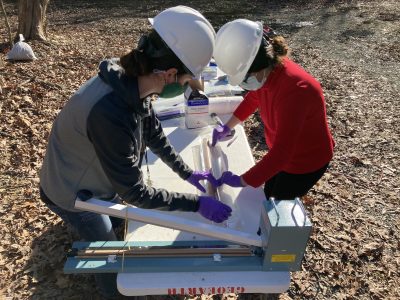Geochemical Predictors of Arsenic Contamination
 Approximately 3 million North Carolinians depend on wells as a source of drinking water, yet it has been estimated that more than 75,000 consume well water with arsenic levels that are thought to be unsafe.
Approximately 3 million North Carolinians depend on wells as a source of drinking water, yet it has been estimated that more than 75,000 consume well water with arsenic levels that are thought to be unsafe.
Researchers from Project 4 seek to understand the fundamental chemical relationships between dissolved metals such as inorganic arsenic, chromium and vanadium, and aquifer rocks and sediment. With these results, they will develop models to predict the vulnerability of groundwater to toxic metal contamination and inform future well placement.
By understanding the factors that lead to or prevent groundwater contamination, better management strategies can be developed to reduce human exposure to toxic metals. Findings from this research will provide key information to help guide new well placement and identify conditions that cause existing wells to be at risk for contamination.
Project Leader

Dr. Owen Duckworth
Owen Duckworth, PhD
Professor and University Faculty Scholar, Department of Crop and Soil Sciences
NC State University
Co-Investigators

Rob Austin
Rob Austin, MS
Extension Specialist, Geographic Information Systems Crop and Soil Sciences
NC State University

Dr. Cass Miller
Cass Miller, PhD
Okun Distinguished Professor, Environmental Sciences and Engineering
Gillings School of Global Public Health
UNC-Chapel Hill

Dr. Jason Osborne
Jason Osborne, PhD
Professor, Department of Statistics
NC State University

Dr. Matthew Polizzotto
Matthew Polizzotto, PhD
Associate Professor, Department of Earth Sciences
University of Oregon

Dr. David Vinson
David Vinson, PhD
Assistant Professor, Department of Geography and Earth Sciences
UNC-Charlotte
